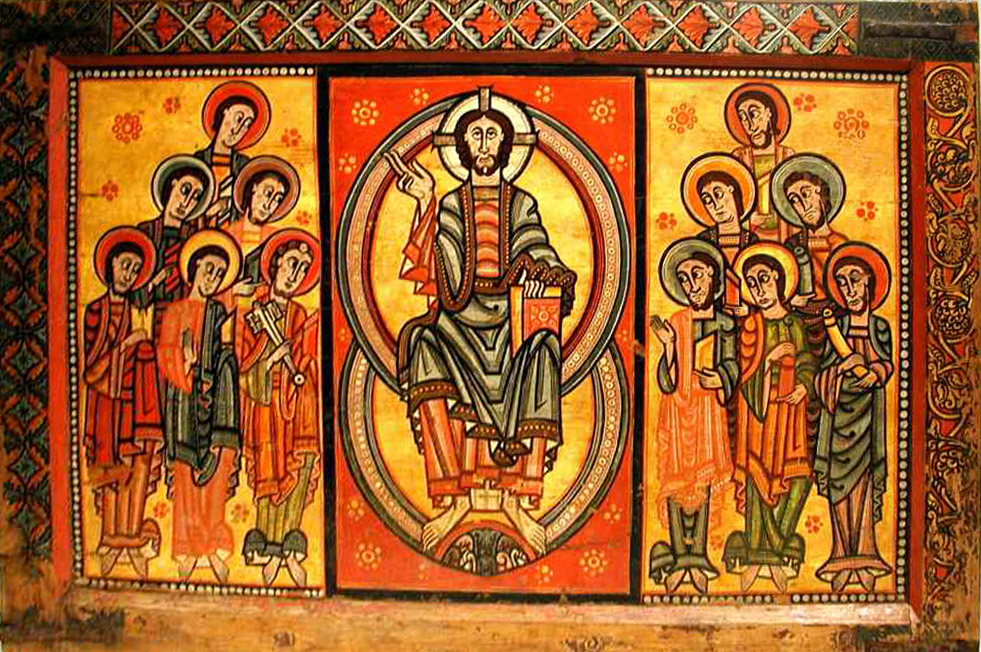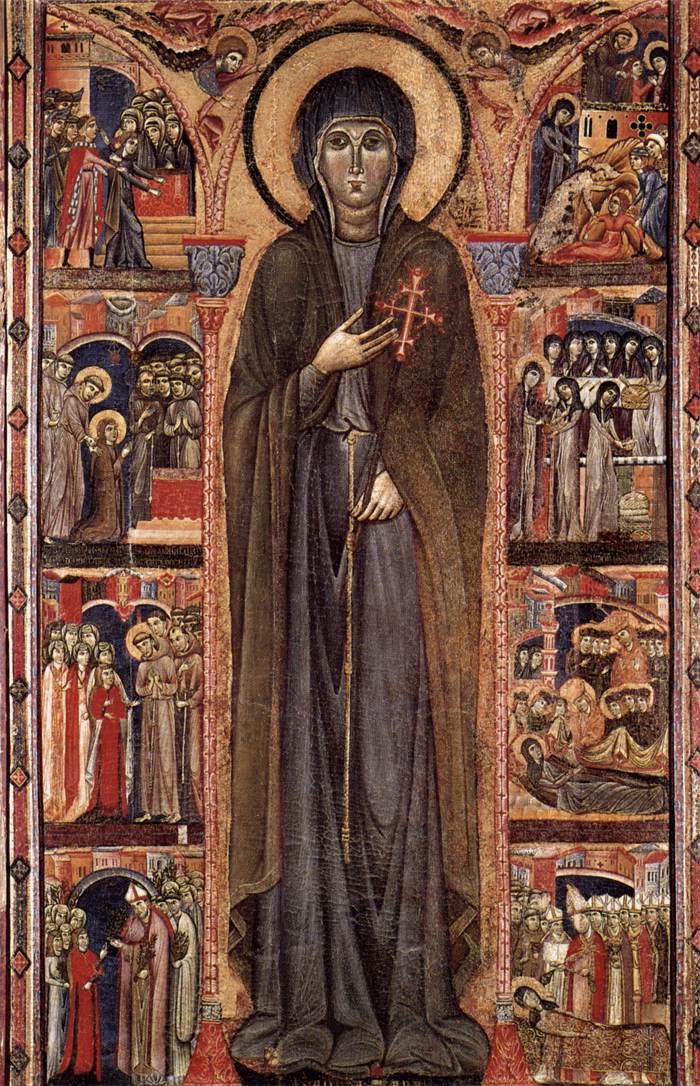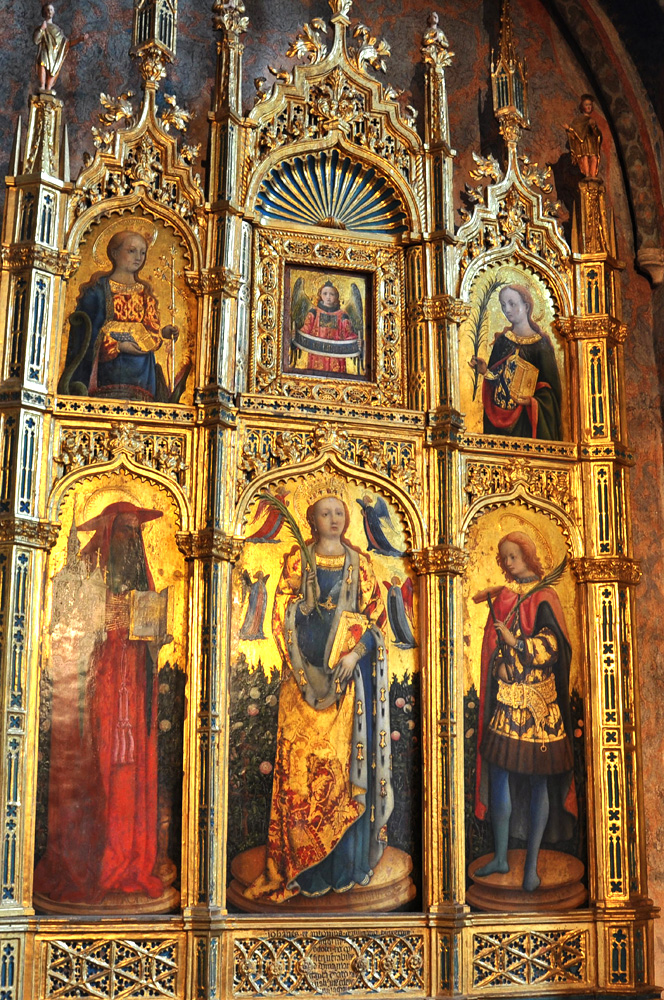Dossals were commonly divided into three vertical registers: Christ or a saint in the center, flanked by two columns of small portraits or narrative images. Originally proportioned like altar frontals, they soon came to be extended vertically, like the second example at right.
As can be seen in that second example, painted images of architectural columns could separate the central portrait from the smaller images. In the 14th and 15th centuries this led to actual physical separation in "polyptychs," the second type of altarpiece. In these the side images are separated from the center by engaged columns or are on hinged "wings," as in the third example at right. The wings and the central panel will customarily be topped by Gothic-style arches.
In some polyptychs the center image is flanked by full-length portraits of other saints. In others sides may have a number of smaller panels with more portraits or with episodes from the saint's life (example). The portraits are almost always painted on gold ground; the episodes will sometimes have a background landscape instead.
During the 14th century more and more polyptychs would have a "predella," a separate strip of panels at the bottom of the work featuring either portraits of saints or narrative episodes (example). The central panel might be reserved either for the most important episode in the story or for a portrait complementing the one directly above.
Dossal altarpieces were vastly outnumbered by newer types after the 13th century, but they did continue to be used from time to time. This altarpiece from the 16th century, for example, is organized in the old style. Similarly, the popularity of polyptych altarpieces waned during the course of the 15th century, but they too retained a place in church art for some time.
In Spain and its colonies, the polyptych was popular in the Baroque era in the form of large wooden "retables" with statues and relief sculptures instead of paintings (example).
What overshadowed the polyptych in the 15th and 16th centuries was a new type that devoted the entire space to one painting. An early example of these "single-field" works was the Boulbon Altarpiece from 1450 (fourth picture at right). When an artist wanted to include different events or portrait groupings in this single painting he would separate them by painted devices such as the cloud in Raphael's altarpiece of the Assumption and Coronation of the Virgin or the mountaintop in his Transfiguration.
In Italy contemporary documents referred to this type of altarpiece as a pala (plural pale). A key difference from the polyptych was the abandonment of gold ground for a background with either a landscape or an interior setting.
The subject matter of these pale could be an episode in a narrative (as in the Raphael), or it could be an enthroned figure with saints stationed on the left and right (example) or a Sacra Conversazione, an image of several saints gathered together from various eras in Christian history.
Prepared in 2022 by Richard Stracke, Emeritus Professor of English, Augusta University.
HOME PAGE

Altar frontal from Catalunya, 12th century, 1280s. (See the description page.)

Altarpiece of St. Clare, 1280s. (See the description page.)

Antonio Vivarini, The Santa Sabina Altarpiece, 1443. (See the description page.)

The Boulbon Altarpiece, Provence, circa 1450. (See the description page.)
MORE IMAGES
- 1260-70: Giunta Pisaon, St. Francis Altarpiece.
- 1350: A late example, the St. Eulalia Altarpiece in Mallorca.
- 1344: Guariento di Arpo, Coronation of the Virgin Altarpiece.
- 1354-57: Andrea di Cione The Strozzi Altarpiece in Santa Maria Novella, Florence.
- 1400: The transitional Trinity Adored by All Saints, from Valencia, retains the kind of arrangement common in dossals but is constructed as a triptych with its three segments quoting the shape of Gothic windows.
- 15th century (?): The Palazzo Bellomo St. Lawrence Altarpiece.
- 15th century (?) In the Altar of the Madonnna and Child at Mariapfarr, Germany, the centerpiece is a statue while the panels on the wings feature paintings.
- 1420-30: The St. Andrew Altarpiece in the Cloisters.
- 1464: Antonio Vivarini, Altarpiece of St. Anthony Abbot.
- 1464-66: In l'Alunno's high-Gothic Altarpiece of the Coronation of the Virgin even the finials have portraits of saints.
- Last quarter of the 15th century: The Flemish Altarpiece of St. Godelieve is unusual in being entirely narrative, with three multi-part panels following the saint's story chronologically from left to right.
- 1490: This single-field painting is the center of a triptych and echoes its organization by means of two painted columns that separate the central scene from those on the sides.
- 1495-1501: A transitional Crucifixion Altarpiece keeps gold ground in the central panel but uses landscapes in the wings.
- 1516: Hans Holbein's St. Sebastian Altarpiece is a triptych in shape but its central painting is like a pala.
- 1696-1700: In Andrea Pozzo's Trinity Altarpiece: a pala is framed by a multitude of architectural elements and statues.
- 1726: Giovanni Odazi, Altarpiece of St. Robert of Molesme.
- Undated (possibly 18th century) A single-field Pentecost altarpiece framed by gilt columns and statues.
- 1547-51: Roque de Balduque, The Cáceres Retable.
- 18th century: The St. Thecla Altarpiece in Burgos, Spain, is one of the finest and most elaborate examples of this type of altarpiece.
- 1742: Manuel de Pedredo, Teresa of Avila Retable.
NOTES
1 This essay draws largely on Ekserdjian's exhaustive study of Italian Renaissance altarpieces; any errors on this page will surely be my own. For the priest's stance at the alter before and after 1215, see Beth Williamson, "Altarpieces, Liturgy, and Devotion," Speculum 79 (2004), 341-406.